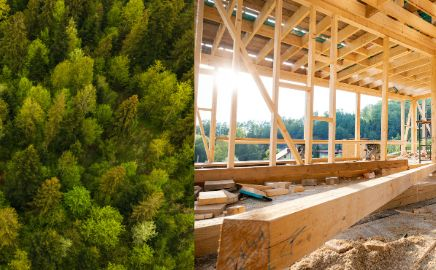News

Organizing for more projects using regional wood: round table report
On November 7, 2023, the cluster organized a conference on the theme of adding value to regional wood, in partnership with Critt Bois d'Epinal, Fibois Grand Est and Crédit Agricole Alsace Vosges. After an introduction to the subject by Laurent Bléron, Director of ENSTIB, and an initial round table to take stock of the current situation, the second round table aimed to discuss how players in the sector can organize themselves to encourage more projects using regional wood. Here's a summary of this sequence, which brought together Eric de Taddeo from Mathis SAS, Michael Perez from BtoG, Quentin Remy from the Pôle Innovation bois d'Épinal, Claude Valentin from HAHA Architecture and Thibaud Surini from Fibois Grand Est as moderator.
Diverse motivations
For architect Claude Valentin, while the issue is simpler for project owners who can use their own resources, it remains complex for other profiles. In the first case, he cites the example of the construction of a single-family home where the wood used was owned by the future occupants. The use of this resource gave meaning to the project, anchoring it in a family history. This component guided the design, with a strong sensitivity to the place of the material used in the history of the house, counterbalancing the highly technical aspect of a construction project.
There are other reasons for using local wood. In the private sector, where the building is a real-estate asset to be valued, new pressures linked to non-financial criteria are emerging: ecology, proximity to the region and the meaning given to construction are levers to be considered. He observes a shift in this direction.
Quentin Rémy from Pôle Innovation in Epinal, France, attests to the importance of political will. In the case of his building, the aim was to make the most of the local hardwoods. For him, such a project requires committed players: a willing project manager ready to commit to the engineering required for the experiment, a carpenter who went out to recruit the laminators and sawyers.
Claude Valentin confirms that prescribing a project beyond technical criteria is a strategic act. It's a way of influencing the area in which the project's various stakeholders operate. If politicians decide to make it an exemplary project, it can be seen as a development lever for the region. He cites the example of the construction of the Tendon market hall. The starting point for the project was the analysis of the disappearance of several regional sawmills due to reduced access to local resources. The aim was to create a public procurement mechanism that would benefit them. This desire, coupled with the need to use an abundant local resource, set the local authority in motion to build a project that favored local sawing from regional beech.
Renovation as a lever for development
Renovation will be the future market for regional wood, according to Claude Valentin. The architect explains that in this market, local wood has a number of advantages: the diversity of species, calibers corresponding to diverse needs, parquet flooring, ceilings, wood is a solution to many renovation projects, and local wood allows for more nuance and personalization.
Eric De Taddeo of the Mathis construction company highlights the difficulty of defining local wood. While for primary processors, it means working with wood harvested close to the factory, for secondary processors, the concept is more vague and can be counterproductive. He recommends talking about reducing environmental impact. The origin of supplies is not the only lever. He points out that2nd transformation is not necessarily adapted to shorter circuits, and that the tool must adapt to work with new species.
The industrialist also stresses the importance of taking normative aspects into account. He gives the example of the Olympic Games. The French government wanted to use bio-sourced materials, in particular structural wood (the requirement was for 30% wood, and French wood in particular). The industries were set up to meet the demand. But the technical solutions recommended required regulatory compliance, which was not always in phase with the deadlines and budgets imposed.
Give preference to local wood in public procurement contracts
With regard to public procurement contracts, Michael Perez, legal counsel at BtoG, points out that it is not possible to specify the origin of wood in public procurement contracts. However, solutions do exist to enhance the value of regional woods (possible specifications on skills, carbon footprint, integration hours, for example). In the lawyer's view, this issue needs to be taken into account right from the planning stage. He points out that labels do not guarantee that local wood will be chosen, because of the obligation to allow equivalent solutions. He recommends focusing on the distribution of points awarded in calls for tender, to favor regional woods. Manufacturers need to respond to the scoring system rather than the specifications, and be clear about the implications of point allocation. Buyers also need to see how their choices are reflected in the scale. For example, is the client prepared to pay more for a better carbon footprint? He warns, however, that local and carbon do not always go hand in hand, with transport accounting for only 1/5 of the impact.
For the legal expert, one argument to focus on is that of local employment. It's an argument that project owners, including private ones, are sensitive to. If the will is there, then the arguments are there. He cites the number of integration hours, life-cycle costs and the preservation of biodiversity as arguments that enable us to move beyond the logic of price.
He points out that Europe is currently working on the subject, even if the definition of local at European level may differ from our vision in France. In France, from 2026, sustainability criteria should also be included in public procurement contracts.
Training and awareness-raising
Everyone agrees on the need to step up training and awareness-raising to make up for the lack of knowledge on the part of building owners about what the regulations allow, the lack of training among architects on the use of regional wood, and the lack of knowledge among companies to meet demands. The skills of companies need to be developed to meet the high demands of specifications.
Over and above individual training, it's a new way of working together that's key. Claude Valentin calls for the creation of a cooperative space that would make it possible to forecast material requirements on a multi-year basis, organize sourcing and plan implementation.












No comment
Log in to post comment. Log in.